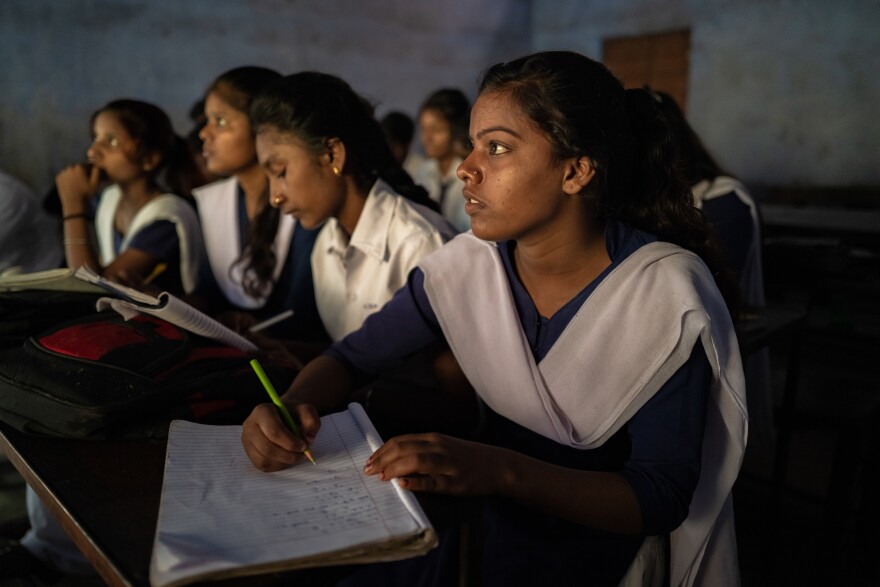Before sunset, in the 110-square-mile mining region of Jharia in eastern India, an ensemble of girls dances near an opencast coal mine. Come sunrise, they'll be back at the mines for another reason: survival.
"We're afraid, but we're bound to go with the risks," says 16-year-old Anjali, who scavenges from her local mine — typically between 4 a.m. and 10 a.m. — for a few dollars worth of coal. (NPR is only using the girls' first names because this kind of coal collecting is against the law.) An estimated 250 people in her rural village, including 65 children, fill their baskets at the pits, then sell the rocks in local markets or keep them for free household fuel.
Poverty abounds across the coal-rich state of Jharkhand, home to Jharia and some of India's largest coal reserves. The people of Jharkhand rely on the coal industry for jobs, pensions, electricity, fuel and more, with at least a few million of the state's 40 million residents believed to be informal or illegal coal workers. Jharia is essentially one large coalfield dotted with vulnerable villages. There, Anjali and other poor residents participate in the mining economy to meet their basic needs.




A risky place to live
Anjali's family home lies just about 800 feet from Ghansadih Colliery (a coal mine and its surrounding structures), one of at least 30 pits in the region operated by Bharat Coking Coal Limited, a subsidiary of the state-owned Coal India.
It's a risky place to live, with poor air quality, underground fires and splitting or sinking land. Families have been facing relocation for years, and Anjali fears the mine and fires will one day displace her family and separate her from her friends. She says some of the homes in their village, Ghansadih, have already been damaged or destroyed by the land subsidence and fires from decades of large-scale mining activity. Bharat Coking Coal Limited did not respond to NPR's request for comment.
Opencast coal mining, in which the rocks are extracted from pits and not tunneled mines, can destroy the land and cause significant air pollution. Coal accounts for about 70% of electricity generation in India, which is the third-biggest global emitter of greenhouse gases. One study estimates that in 2018, more than 30% of the country's annual deaths for people over the age of 14, as well as one in five deaths worldwide, were attributable to air pollution from fossil fuels.



Lessons in the arts for kids who scavenge
Trapped between poverty and pollution, Anjali says, "No one thinks about us, apart from Mr. Pinaki."
About five years ago, Pinaki Roy, a 55-year-old educator who was born in Jharia, founded the Coalfield Children Classes to try to help some of the thousands of young people balancing scavenging and studying. Today, a hundred coal collectors ages 10 to 23, including Anjali and her dance troupe, frequent Roy's free after-school lessons in English, computers and the arts, including dancing and painting.
"The larger society that calls them coal thieves must understand why they go into the dangerous mines," says Roy, citing household poverty as the driving force. "These children and young adults are hardworking, honest and talented. They're needy, not greedy, and I want to change their mindsets from coal picking to improving their socioeconomic situations through study." His small initiative assists many attendees with their school fees, in association with a Paris-based NGO, since public education in India is only free and compulsory for children ages six to 14. In 2022, all of his pupils were also regularly attending government-run schools or preparing for post-secondary coursework.



Each year on November 9, the Coalfield Children Classes community observes "Better Lifestyle Day," an awareness-raising event that Roy launched in memory of Chanda, a former student who was killed on that day in 2018. Just four months after Roy started the classes, a mining tunnel near the 13-year-old girl's village caved in on her and two others as they scavenged for coal.
"Chanda was a very dear student, like a daughter," recalls Roy, saying her mother was grateful he tried to prepare her for life beyond the coalfields. "After she died, her mother said to me, 'Your daughter is dead, you couldn't save her.'
The educator adds, "Poverty can be a curse." Still, he holds steadfast that coal doesn't have to be his students' destiny, even if so many people in the region work in or around the mines.


In 2016, in Ghansadih, Savitri, then 16, spoke of the face and neck burns she sustained at 13 after her clothing caught fire when she lit her household's coal oven. Two years later, the teenager and her younger siblings were welcomed into Roy's Coalfield Children Classes community. Now Savitri is studying to be a nurse with her savings, a scholarship from the Coalfield Children Classes and private donations. "I'm still working in the coalfields because I don't have another option," the young woman with ailing parents explains. "If I get a nursing job, I'll be able to protect my family in a better way."
She compares her family of seven to a garland: "Each member is a flower, and I'm the thread that holds us together."
Elle Kurancid is a journalist, story editor and scriptwriter
who works in the Mediterranean region. Walaa Alshaer is a UAE-based Egyptian photographer.
Copyright 2023 NPR. To see more, visit https://www.npr.org.



